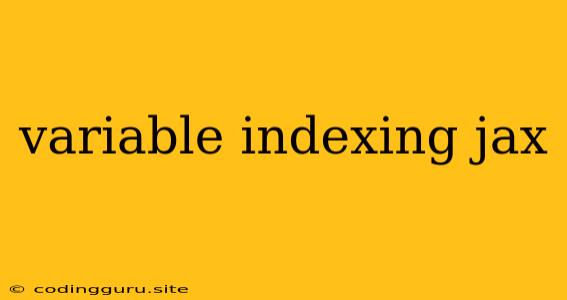Understanding Variable Indexing in JAX: A Comprehensive Guide
JAX, a high-performance numerical computation library, empowers users to perform complex mathematical operations on arrays. Within this realm, variable indexing plays a crucial role in accessing and manipulating specific elements within arrays. This guide delves into the nuances of variable indexing in JAX, providing insights into its application and underlying principles.
What is Variable Indexing?
Variable indexing in JAX refers to the use of variables to dynamically select elements within arrays. Unlike fixed indices, which directly specify the position of elements, variable indexing allows you to access elements based on the values held by variables.
Why use variable indexing?
- Flexibility: Enables dynamic element selection based on changing conditions or data.
- Efficiency: Optimizes operations by selectively targeting relevant elements.
- Control: Provides fine-grained control over data manipulation.
Key Concepts in Variable Indexing
- Arrays: Fundamental data structures in JAX, holding collections of elements.
- Indices: Integers representing the positions of elements within an array.
- Variables: Placeholders that store values, which can be used as indices.
Implementing Variable Indexing in JAX
Example 1: Accessing Elements Using Variables
import jax.numpy as jnp
# Create an array
arr = jnp.array([1, 2, 3, 4, 5])
# Define a variable representing an index
index = 2
# Access the element at the specified index
element = arr[index]
# Print the result
print(element) # Output: 3
In this example, index acts as a variable index, pointing to the third element (index 2) within the array arr.
Example 2: Using Variable Indexing for Conditional Selection
import jax.numpy as jnp
# Create an array
arr = jnp.array([1, 5, 3, 7, 2])
# Create a condition for selecting elements
condition = arr > 3
# Use variable indexing based on the condition
selected_elements = arr[condition]
# Print the result
print(selected_elements) # Output: [5 7]
Here, the condition arr > 3 generates a boolean array where True represents elements greater than 3. The variable indexing mechanism then selects the elements corresponding to True values in the condition.
Example 3: Advanced Variable Indexing with Multiple Dimensions
import jax.numpy as jnp
# Create a 2D array
arr = jnp.array([[1, 2], [3, 4], [5, 6]])
# Define variable indices for rows and columns
row_indices = jnp.array([0, 2])
col_indices = jnp.array([1, 0])
# Access elements using variable indices
selected_elements = arr[row_indices, col_indices]
# Print the result
print(selected_elements) # Output: [2 5]
In this scenario, we use two variable indices, row_indices and col_indices, to select specific elements based on their row and column positions.
Benefits of Variable Indexing
- Dynamic Selection: Adapts to changing conditions and data without requiring explicit code modifications.
- Efficient Operations: Selects only relevant elements, optimizing resource usage.
- Data Manipulation: Enables customized transformations based on element positions.
Conclusion
Variable indexing empowers users to manipulate JAX arrays with flexibility and precision. By leveraging variables to dynamically select elements, developers can write more concise and efficient code. This powerful technique finds applications in various scenarios, ranging from conditional operations to data filtering and manipulation. By understanding the principles and applications of variable indexing, you can unlock the full potential of JAX for numerical computation.
